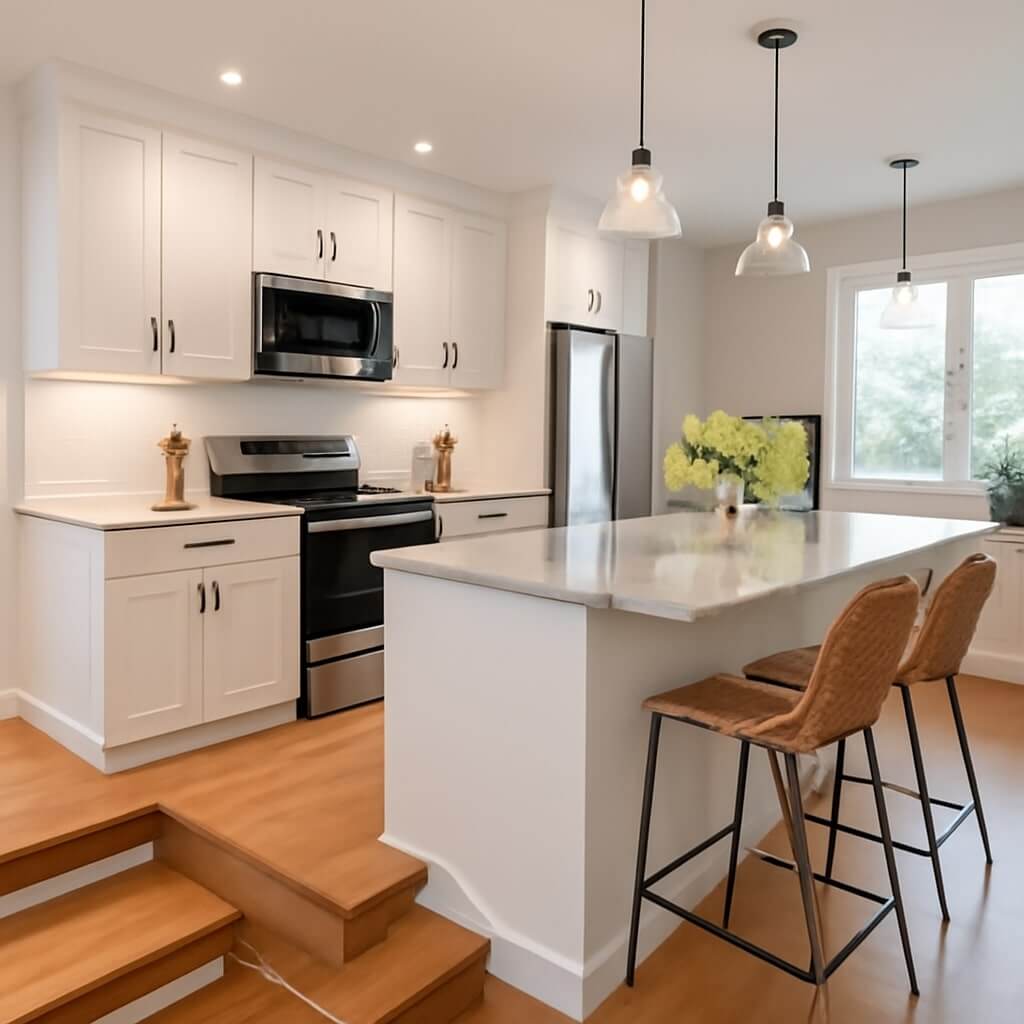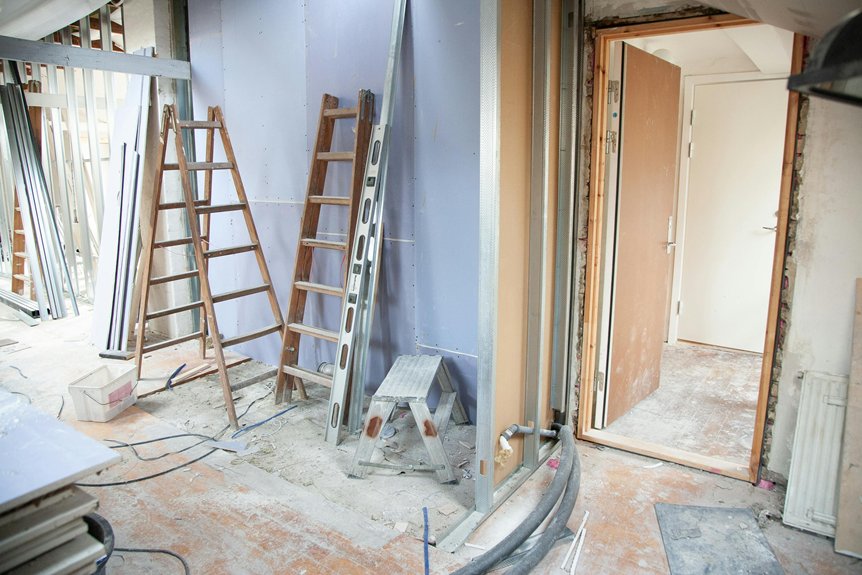When you’re planning a kitchen remodel in Seattle, understanding the factors that influence costs is vital. Your kitchen size and layout set the stage for material and labor needs. The choices you make regarding materials and fixtures can greatly affect your budget. Additionally, the complexity of your design and local regulations can add unexpected expenses. Let’s explore these elements further to guarantee your remodel aligns with both your vision and financial goals.
Key Takeaways
- Kitchen size and layout significantly affect material needs and labor costs during a remodel.
- Material selection, including countertops and cabinetry, greatly influences both aesthetics and overall budget.
- Labor costs fluctuate based on local market conditions, project complexity, and the need for skilled tradespeople.
- Compliance with safety regulations and obtaining necessary permits can add time and expenses to the remodeling process.
- Seasonal timing of the remodel can impact labor costs and material availability, potentially leading to savings.
Kitchen Size and Layout
When you’re planning a kitchen remodel in Seattle, the size and layout of your kitchen play an important role in determining costs.
Kitchen dimensions dictate not only the materials you’ll need but also the layout options available. For instance, a galley kitchen may require less cabinetry than a sprawling open-concept design, impacting your budget.
Additionally, considering whether you’ll opt for an L-shaped, U-shaped, or island layout can greatly influence labor costs and the need for plumbing or electrical adjustments.
Understanding your kitchen’s dimensions and layout options is vital for making informed decisions and managing expenses effectively.
Choice of Materials
When you choose materials for your kitchen remodel, the options can greatly impact both aesthetics and budget.
Selecting the right countertop material, whether it’s quartz, granite, or laminate, affects not only the look but also the durability and maintenance of your space.
Similarly, the quality of cabinetry you opt for can dictate the overall functionality and longevity of your kitchen, making it essential to weigh your choices carefully.
Countertop Material Selection
Selecting the right countertop material for your kitchen remodel can greatly impact both aesthetics and functionality.
Consider these factors when making your choice:
- Durability: Granite vs. quartz—granite offers natural beauty but can require sealing, while quartz is non-porous and low-maintenance.
- Cost: Typically, granite is less expensive than quartz, but the price can vary based on quality and installation.
- Eco-Friendly Options: Look for sustainable materials like recycled glass or bamboo, which offer unique styles and minimize environmental impact.
Cabinet Quality Options
Choosing the right cabinet materials is essential for achieving both style and functionality in your kitchen remodel. The choice of cabinet styles and finishes can dramatically impact your kitchen’s look and durability. Here’s a quick comparison of popular materials:
| Material | Characteristics |
|---|---|
| Solid Wood | Durable, customizable finishes |
| Plywood | Strong, resistant to moisture |
| MDF | Smooth surface for paint finishes |
| Particle Board | Cost-effective, less durable |
Labor Costs
Although you might focus on materials and design when planning a kitchen remodel in Seattle, labor costs can greatly impact your overall budget. The local labor market and wage fluctuations can lead to significant variations in your expenses.
Here are three key factors influencing labor costs:
- Experience Level: Skilled labor often demands higher wages due to expertise.
- Project Timeline: Urgent projects may incur premium rates for quicker completion.
- Seasonality: Labor costs can rise during peak remodeling seasons, affecting availability and pricing.
Understanding these elements will help you budget more accurately for your kitchen remodel.
Design Complexity
When considering your kitchen remodel, the complexity of your design plays a pivotal role in the overall cost.
If you’re planning significant layout changes, incorporating custom features, or selecting high-end materials, be prepared for a potential increase in expenses.
Each decision you make not only affects the budget but also the functionality and aesthetic appeal of your new kitchen.
Layout Changes
How do layout changes impact your kitchen remodel budget? When you ponder shifting things around, the costs can rise quickly. A well-thought-out layout not only enhances aesthetics but also improves traffic flow, especially in an open concept design.
Here are three key factors to contemplate:
- Structural Changes: Moving walls or adding support beams can greatly increase expenses.
- Plumbing and Electrical Work: Relocating sinks or appliances requires extensive work, driving up costs.
- Design Complexity: More intricate layouts often need professional design services, adding to your overall budget.
Careful planning guarantees you balance functionality and cost effectively.
Custom Features
While customizing your kitchen can truly elevate its appeal, incorporating unique features often adds complexity to your remodel.
Custom cabinetry options, for instance, require precise measurements and skilled craftsmanship, which can drive up labor costs. When you choose intricate designs or specialty finishes, expect extended lead times and potential adjustments during installation.
Similarly, unique backsplash designs can enhance visual interest but may involve complex tile layouts or custom cuts, affecting both time and budget.
Balancing your vision with practical considerations is essential, as these custom elements can greatly influence the overall cost of your kitchen remodel in Seattle.
Material Selection
Custom features often lead to a deeper exploration of material selection, as the choices you make can greatly impact both design complexity and overall costs.
Consider these factors:
- Sustainable Materials: Opting for eco-friendly options can elevate your kitchen’s aesthetics while supporting your budget considerations.
- Durability vs. Cost: Balancing high-quality, long-lasting materials with affordability is essential.
- Design Complexity: Intricate designs often require specialized materials, increasing both labor and material costs.
Fixtures and Appliances
When planning your kitchen remodel in Seattle, the selection of fixtures and appliances greatly impacts both functionality and overall cost.
You’ll want to explore various fixture styles, from modern to farmhouse, as these choices can enhance your kitchen’s aesthetic while affecting your budget.
Additionally, the appliance brands you choose matter greatly; high-end brands typically come with a higher price tag, but they often offer better energy efficiency and durability.
Balancing style and practicality is vital, so consider how each fixture and appliance contributes to your vision while staying within your financial limits.
Prioritize wisely to create a stunning, functional kitchen.
Plumbing and Electrical Work
As you immerse yourself in your kitchen remodel in Seattle, understanding the intricacies of plumbing and electrical work is essential, as these elements not only guarantee safety but also greatly influence your overall budget.
Consider these key factors:
- Plumbing Upgrades: Updating pipes or fixtures can prevent leaks and improve water efficiency.
- Electrical Inspections: Ensuring your wiring meets code can prevent hazards and future issues.
- Labor Costs: Professional plumbers and electricians charge varying rates, impacting your overall expenses.
Investing in these areas not only enhances safety but also enhances the functionality and resale value of your kitchen.
Permits and Regulations
When you’re planning a kitchen remodel in Seattle, understanding local building codes is essential to guarantee compliance and avoid costly delays.
You’ll need to navigate the permit application process, which involves submitting detailed plans and possibly paying fees.
Additionally, be prepared for inspection requirements that verify your work meets all safety and regulatory standards.
Local Building Codes
Maneuvering through local building codes in Seattle is essential for a successful kitchen remodel, as these regulations guarantee safety and compliance with city standards.
Understanding these codes can save you time and money. Here are three key aspects to take into account:
- Building Permits: You’ll need permits for structural changes, electrical work, and plumbing updates.
- Code Compliance: Verify your design meets safety regulations, including ventilation and accessibility.
- Inspections: Be prepared for inspections at various stages to confirm adherence to local codes.
Ignoring these elements can lead to costly fines and delays, so stay informed and compliant throughout your project.
Permit Application Process
Maneuvering through the permit application process for your kitchen remodel in Seattle can feel overwhelming, but understanding the steps involved can simplify the experience.
First, identify the relevant permit types, such as building, electrical, or plumbing permits, depending on your remodel’s scope. Each type has specific requirements, so be thorough in your submissions.
Typically, the application timeline ranges from a few days to several weeks, influenced by the complexity of your project and the current workload of the city’s permitting department.
Staying organized and proactive can help you navigate this process efficiently, keeping your remodel on track.
Inspection Requirements
After securing the necessary permits for your kitchen remodel, you’ll need to understand the inspection requirements that follow.
Inspections guarantee safety and compliance with local regulations, but they can also impact your budget and timeline. Here are key points to contemplate:
- Inspection Costs: Factor in fees for each inspection, which can vary based on complexity.
- Inspection Timeline: Schedule inspections promptly to avoid delays in your remodel project.
- Multiple Inspections: Be prepared for several rounds of inspections, especially if you’re making significant structural changes.
Understanding these elements will help you manage costs and keep your project on track.
Custom vs. Stock Options
When considering a kitchen remodel in Seattle, choosing between custom and stock options greatly impacts both the design and budget.
Custom cabinetry offers tailored solutions, allowing you to maximize space and match your specific style. However, this quality often comes with a higher price tag and longer lead times.
On the other hand, stock cabinetry provides a more budget-friendly option, with ready-made designs available for quick installation. While stock options may limit your design choices, they can still deliver a great look.
Ultimately, your decision hinges on your budget, timeline, and personal preferences for functionality and aesthetics.
Timing and Seasonality
While many homeowners in Seattle mightn’t realize it, the timing of your kitchen remodel can greatly influence both costs and project efficiency.
Understanding timing trends and seasonal discounts can save you money and streamline your project. Here are three key factors to take into account:
- Off-Season Remodeling: Typically, late fall and winter offer lower demand, which can result in reduced labor costs.
- Material Availability: Certain materials may be cheaper during specific seasons due to promotional sales.
- Contractor Schedules: Hiring contractors during slower periods might lead to quicker project completion and better pricing.
Timing can considerably impact your remodeling experience!
Unexpected Repairs and Changes
Even with careful planning and timing, unexpected repairs and changes can arise during a kitchen remodel, impacting both your timeline and budget.
You might encounter unexpected structural issues, such as rotting beams or outdated plumbing, that demand immediate attention. These hidden damage discoveries can greatly increase costs and extend your project timeline.
It’s essential to set aside a contingency fund to address these potential surprises. By anticipating these challenges, you can minimize stress and adjust your budget accordingly.
Embracing flexibility in your plans will help you navigate these unforeseen complications while achieving your desired kitchen transformation.
Conclusion
In summary, when planning your kitchen remodel in Seattle, it’s essential to take into account all the factors we’ve discussed. From the size and layout of your space to the materials you choose and the labor costs involved, each element plays a significant role in your overall budget. By anticipating potential challenges and understanding local regulations, you can make informed decisions that align with your vision and financial goals. Ultimately, careful planning will lead to a successful and satisfying remodel.




